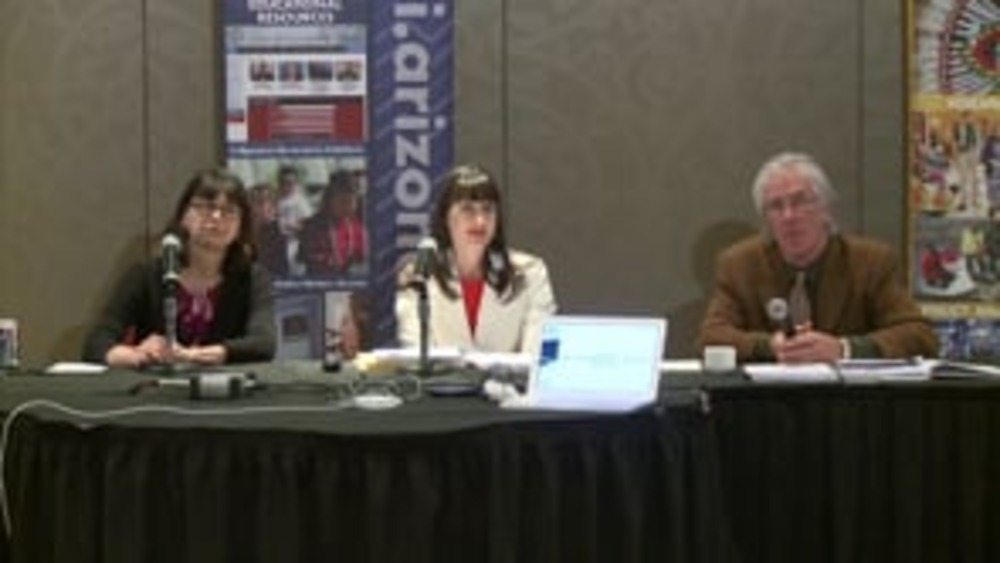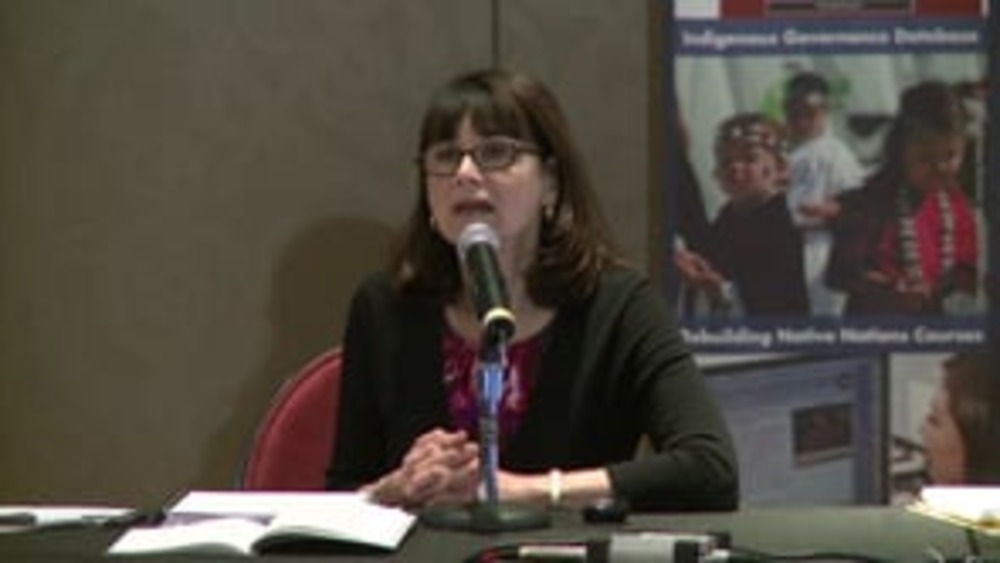Scholar Carole Goldberg discusses the internal considerations that Native nations should ponder when deciding whether and how to change their citizenship criteria.
Additional Information
Goldberg, Carole. "Internal Considerations in Redefining Citizenship." Tribal Constitutions seminar. Native Nations Institute for Leadership, Management, and Policy, University of Arizona. Tucson, Arizona. April 3, 2013. Presentation.
Transcript
"So what are some of the things to think about from within your own community?
Well, as we’ve said many times already in this brief amount of time this morning, constitutions need to have legitimacy within your community, which means they have to have continuity within the values and beliefs within your community. That’s not to say that those are static, that they never change, but there must be some organic sense that this reflects our community. So what does your community understand to be the expectation for someone to belong to that community? There’s a lot that’s been written by people in my academic world about whether kinship and descendants and blood quantum are new constructs for tribal citizenship that don’t really fit historical ways of understanding, of belonging for tribal communities. And they point to the fact that hundreds of years ago individuals who were not biologically related to members of a community might be incorporated through a variety of means -- through marriage, through captivity in warfare, through political alliances. For a lot of reasons people might be brought into a community even though they’re not biologically related. So why should native nations today care about descendants?
Well, I think there is an argument to be made that kinship has always been a fundamental component of belonging in tribal communities and how outsiders were viewed 200 or 300 years ago may not be the same way that outsiders would be viewed today. There is not the same concern 200 or 300 years ago about being overwhelmed by a population of immigrant colonizers from across the ocean. That wasn’t an issue 200 or 300 years ago and so maintaining some expectation of kinship may very well accord with foundational beliefs in a community. How that kinship is understood is going to vary from place to place, blood quantum may or may not capture that, but the idea that kinship matters I think is something to be considered from an internal perspective.
At the same time, another important consideration is going to be maintaining numbers, I suggest, and maximizing political impact. So I’ve worked with a number of native nations, and you heard from some even earlier today, who were concerned about reductions in their citizenship numbers over time if they maintain very high percentage descendance requirements.
One interesting example is the Otoe Missouria of Oklahoma, who just a few years ago reduced their percentage descendance requirement from one-fourth to one-eighth. And here’s what their leaders had to say. They said that, ‘Before the change there were about 1,400 enrolled members and only 129 of them were below the age of 18.’ Today, since they changed their requirements there are over 2,500 members, 479 of those are minors and what the chair said at that time, this was announced two years ago, is that, ‘The future of the tribe is more secure both physically and financially.’ The chair noted that a majority of the departments and services offered through the tribes are funded by grants and the higher the number of tribal members served by the grant, it means that the grant funding is generally higher. So there are many political, financial and other reasons. The chair also said, ‘Our tribe has gotten younger. A majority of our new members are younger people. This ensures a strong future for the Otoe Missouria Tribe. With a larger membership we should be able to obtain additional funds from government agencies and maintain and pass on strong traditional values to the growing tribal membership.’ So this was some of the thinking behind increasing the numbers by decreasing descendants’ requirements.
At the same time, Native nations have been concerned that if they expand their citizenship numbers too greatly, they may jeopardize cultural cohesion and they may be jeopardizing those who have shown their loyalty over time by maintaining affiliation. How do you at the same time sustain your numbers over time and at the same time not disburse your citizenship so widely that you lose connection to your home community. You saw from the depiction of the Citizen Potawatomi Nation, with their 27,000, how widespread their population is. How do you ensure that you don’t have a citizenship so large that the people are not vested in protecting their land and their home community? So that’s another issue to consider. And protecting the tribal land base is going to be very important, because if you have lots and lots of citizens who do not reside or feel a connection to that land base, you may very well be in a position where the majority of your citizens are willing to see it despoiled because it will provide benefits to folks who are not present. And that is a danger that one must anticipate in thinking about the design of citizenship and related provisions.
Do you want to secure future generations? What I’ve heard so often in working with Native nations on their citizenship provisions is they want to make sure that their future generations are not left out, that they are able to pass on that tradition and culture and they are able to pass on that sense of belonging. And finally, I want to make sure that I mention, because I’m a lawyer, sorry, that you want citizenship provisions that are not going to be too complicated. You want ones that are not going to turn into huge arguments over time about what they mean.
Okay. So the last thing I’m going to talk about before I let you move onto the next presentation is what are some of the design options that you can be thinking about to try to balance some of these, especially these internal considerations, because sometimes they point in opposing directions and you have to be able to accommodate them. So one thing to be keeping in mind is that citizenship and voting provisions can be considered to some degree on separate tracks. You have to be very careful that you not have classes of citizens. We all know that there until 1919 women were citizens of the United States, but they could not vote. And certainly those in the 18- to 21-year-old range who were being drafted in Vietnam were pretty unhappy that although they were citizens they could not vote on whether they were even going to be involved in a war. So that there is a powerful force that moves towards the convergence of citizenship and voting, but still there are ways to design voting provisions so that you can both expand numbers and at the same time protect your core community and land.
So one of the ways you could do it is you could say, ‘Fine, everybody who’s a citizen can vote, but you must be living in the tribal community in order to have voting privileges.’ In other words, anybody is entitled to come and live there so anybody who makes that choice can be a voting member. That way you can be ensured that those who actually make the decisions are the ones who are invested in that community. Or you could simply say, ‘No absentee voting,’ meaning that you have to really care about this community in order to vote and make the journey. 'Come on voting day, but we will not let you sit in the comfort of your home in Anchorage and vote for what’s going to happen in Citizen Potawatomi.' Or what you could do is what Citizen Potawatomi and Cherokee Nation have done, both of them places with large off reservation populations, and in the case of Cherokee Nation even contested whether there is a reservation, and what they’ve said is, ‘We are going to structure our voting by districts. There will be districts within our territory and then we will construct districts outside our territory that will not have an equal voice, but they will have a voice.’ So the Cherokee Nation actually created a bunch of districts within their territory and then they said, ‘There is a separate voting district that will elect a representative for the off-reservation Cherokees.’ And that way they are not excluded, but they are not given overwhelming influence. Two other suggestions for design that can help you start to accommodate some of these considerations. One is the idea of the right of return and this idea is the idea that anyone who is a lineal descendant would have special privileges to become a citizen if they so chose. So they would have to make an active effort. They would not automatically as a lineal descendant be a citizen, but they would have to make the affirmative effort to affiliate and if they did they would be allowed to do so. It’s not that they would have to be subject to someone else’s decision about it, but they would still have to make the active choice. That way you can ensure that there is some real connection that that person has to the community.
And finally, you can think about doing what Fort Peck did back in the 1980s. They created a category that they called associate members and these were people who were given the belonging to the community because they had members by their title, but it was specifically presented that they would not be voting members and they would not be entitled to the distribution of tribal assets. So these were folks who had a lesser percentage of descendance or blood quantum, but they still were descendants of the nation. They just didn’t qualify for the percentage required under their constitution.
What I want to emphasize is that there are a lot of choices available, in theory. That doesn’t mean that all of these choices are available just because they sound intriguing. You have the hard work, the hard work of political process and I’ve worked with communities that have tried to develop consensus on what should be the criteria for belonging. It’s not easy."


